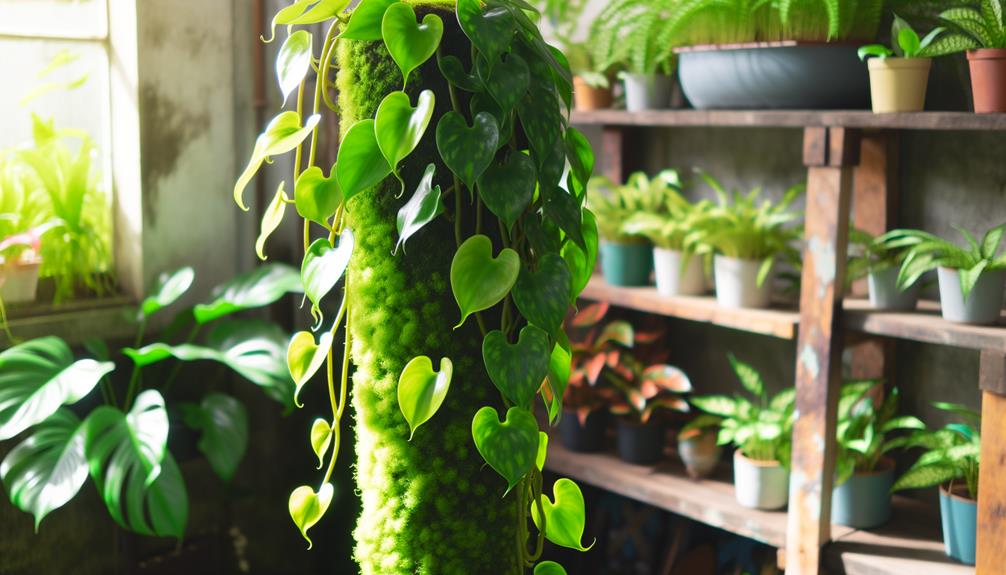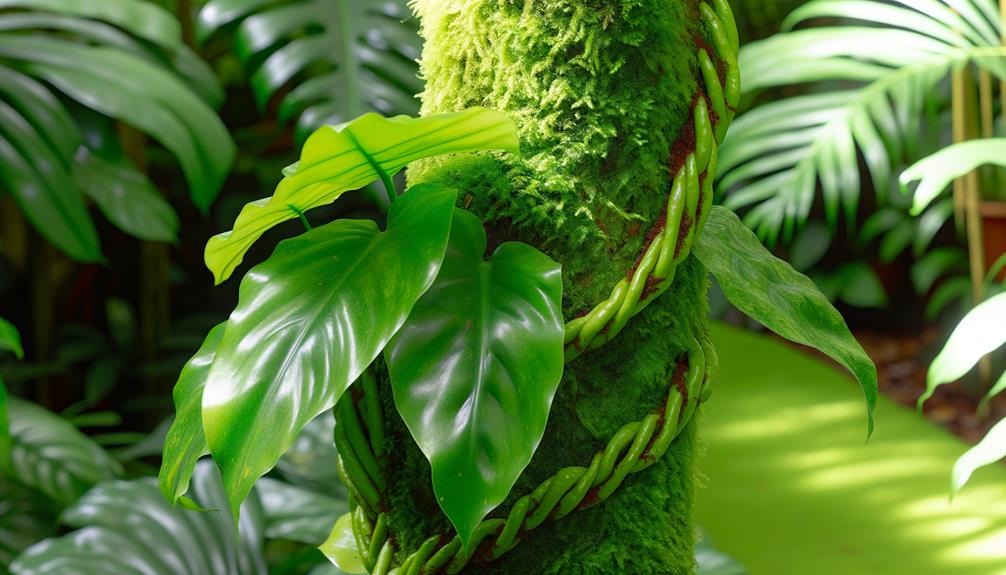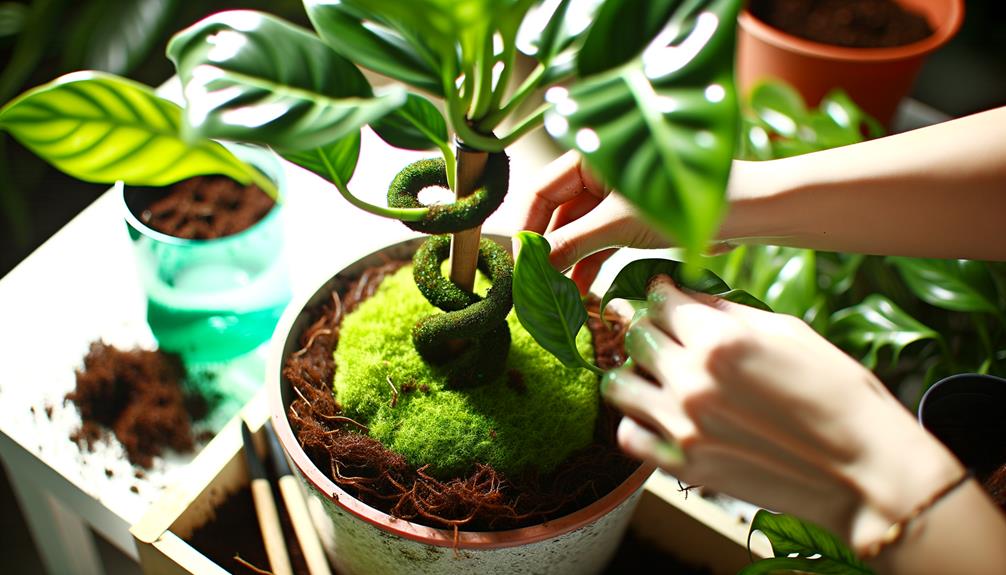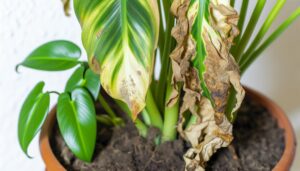Should I Use a Moss Pole for My Philodendron Micans?
Using a moss pole for your Philodendron Micans is extremely beneficial for enhanced structural support, improved aerial root development, and optimal vertical growth. The pole provides a stable medium for your plant's climbing behavior, promoting healthier and more efficient nutrient absorption.
However, consider the maintenance requirements, such as regular misting, and the space needed for vertical expansion. Proper installation and periodic adjustments are essential to avoid potential root damage and ensure stability.
Employing alternative supports like trellises or bamboo stakes can also be effective. For detailed insights into adapting and maintaining the healthiest environment for your plant, continue ahead.

Key Takeaways
- Enhanced structural support: A moss pole provides necessary support for the climbing nature of Philodendron Micans.
- Improved aerial root development: The moist surface of a moss pole encourages healthier and more robust aerial root growth.
- Optimal vertical growth: Using a moss pole promotes vertical growth, reducing sprawling and breakage risks.
- Humidity and nutrient benefits: Regular misting of the moss pole helps maintain humidity and enhances nutrient absorption for the Philodendron Micans.
- Maintenance considerations: Be prepared for maintenance tasks such as regular misting to keep the moss pole moist and effective.
Benefits of Using a Moss Pole

Using a moss pole for Philodendron Micans offers several notable benefits, including enhanced structural support, improved aerial root development, and best vertical growth.
The structural support provided by a moss pole allows the plant to grow in a more natural, upright manner, reducing the risk of sprawling and breakage. Moreover, the moist surface of the moss pole encourages the development of aerial roots, which can absorb nutrients and water more efficiently. This leads to healthier growth overall.
Vertical growth facilitated by the moss pole optimizes light exposure, promoting photosynthesis and robust foliage development. In addition, a moss pole can help mimic the plant's natural habitat, thereby promoting a thriving and aesthetically pleasing indoor garden environment.
Potential Drawbacks
While the benefits of using a moss pole for Philodendron Micans are significant, there are also potential drawbacks that should be considered to guarantee plant care and growth at its best.
- Maintenance Requirements: Moss poles require regular misting to maintain adequate moisture levels, which can be time-consuming for some plant owners.
- Root Damage Risk: Improper installation or frequent adjustments of the moss pole can lead to root damage.
- Space Constraints: Philodendron Micans with a moss pole may necessitate more vertical space, potentially limiting placement options within a home.
- Initial Adjustment Period: Plants may take time to acclimate to the moss pole, potentially causing a temporary slowdown in growth.
Understanding these potential drawbacks is essential for ensuring that your Philodendron Micans thrives ideally.
How to Install a Moss Pole

To set up a moss pole correctly for your Philodendron Micans:
Start by selecting a suitably sized pole that matches the height and structure of your plant.
Guarantee the pole is moist to promote aerial root attachment.
Insert the pole deeply into the pot, anchoring it securely within the soil for stability.
Gently fasten the Philodendron Micans to the pole using soft plant ties or garden tape, avoiding constriction of the stems.
Position the plant's stems and leaves to maximize contact with the moss pole, promoting vertical growth.
Regularly mist the pole to maintain moisture, which supports root adherence.
Monitor the plant's progress and adjust ties as needed to accommodate growth, ensuring peak support and health.
Alternative Support Options
Although a moss pole is a popular choice for supporting Philodendron Micans, various alternative support options can also effectively encourage vertical growth and overall plant health. These alternatives can be tailored to specific aesthetic preferences and spatial constraints.
Here are four viable options:
- Trellises: Vertical or fan-shaped trellises provide ample support and facilitate expansive growth patterns.
- Bamboo Stakes: These are unobtrusive and can be positioned strategically to guide the plant's growth.
- Coir Poles: Like moss poles, these offer a natural appearance and excellent moisture retention.
- Wall-mounted Supports: Using hooks or wire grids on walls can create a visually striking display while providing robust support.
Each option offers unique benefits, enabling plant enthusiasts to choose the most suitable method for their specific needs.
Tips for Healthy Growth

Maintaining peak health and robust growth for your Philodendron Micans involves sustaining appropriate light levels, humidity, and soil conditions.
Ideal light involves bright, indirect sunlight to prevent leaf scorching while promoting photosynthesis.
For humidity, aim for levels around 60-70%, achievable through regular misting or a humidifier.
Soil should be well-draining, rich in organic matter, and slightly acidic with a pH of 5.5 to 6.5.
Regular feeding with a balanced, water-soluble fertilizer during the growing season supports nutrient needs.
Pruning dead or yellowing leaves encourages new growth and prevents disease.
Additionally, consistent watering is essential: keep the soil evenly moist but avoid waterlogging to prevent root rot.
Monitoring these factors guarantees your Philodendron Micans thrives.
Conclusion
To sum up, the decision to employ a moss pole for Philodendron micans can be likened to the choice between a high-maintenance relationship and blissful solitude. While the moss pole offers structural support and promotes vertical growth, it also demands regular upkeep and vigilance.
Alternative supports or laissez-faire approaches may suffice for the less committed. Ultimately, the plant's health hinges more on consistent care than on the mere presence of a moss pole, a botanical crutch for the ardent but weary gardener.






